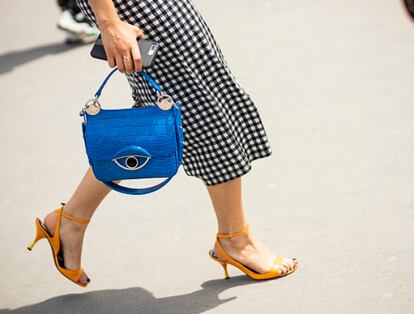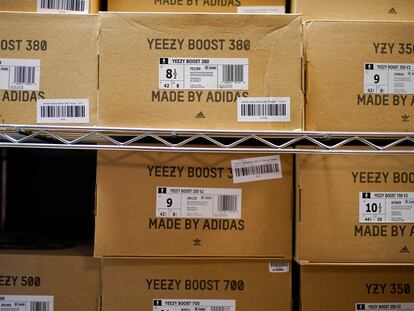From hydration to foot yoga: How to go from shoes to sandals without the dreaded blisters
These remedies can prevent the painful viacrucis involved in switching to summer footwear

There’s only one thing worse than spending a hot day wearing boots or tightly laced oxfords: putting on sandals that leave an annoying and painful friction wound. Those who know the sensation will recognize the intense burning: each step feels like rubbing lemon and salt on a wound. It doesn’t stop when you get home and take your shoes off, but continues the next day when you have to leave again. But summer is here, and as the temperature climbs, the change of footwear is inevitable. For those with sensitive skin, a history of blisters or feet susceptible to rashes, we have made this guide of practical, easy and expert-approved advice.
Start with hydration
Tamara Iglesias, director of Podology at the Margaret Dabbs London podology clinic in Coruña, says that “we can avoid these problems if we regularly hydrate our feet, preferably daily.” Ángel María García, the founder of Biocosmetic, the Spain distributor of the Swiss foot-care brand Pedicare, agrees. “Lack of hydration reduces the skin’s elasticity and ability to protect itself against the friction of the shoe on it. That’s why it’s important to take care of the skin of the feet all year, hydrating them as much as possible depending on the activity we’re doing and the shoes we will wear.”
The oil trick
To keep our feet hydrated, we can reuse body or facial oil. “To prevent a change of shoes from affecting the health of our skin, the ideal is to maintain a care routine. In this case, in addition to a good pedicure or tools like foot files, I suggest using products that guarantee the feet’s nutrition and elasticity. We can use body care products rich in regenerating oils, or even our facial oil, after showering,” says Estefanía Nieto, technical director of Omorovizca and hydration expert.
Powders yes, talcum no
“If we have feet that tend to be sweaty, or we’re going to be in a warm, humid place, we suggest using foot powders before putting on sandals to reduce sweat. It is important that they don’t contain talcum, as it can block the pores,” says podologist Tamara Iglesias.
Soften sandals with lotion
This is a remedy passed down from generation to generation. No one knows how it began, but it works. Applying lotion can help soften the straps of leather sandals.
Multifunctional deodorant
Sweaty feet can also cause infections, Tamara Iglesias warns. “What happens with sweating is that it can make the foot move around more, causing more possible rubbing. To avoid it, using our deodorant on our feet can be a good idea, but I also advise keeping your feet very well cared for. If the feet are smooth and hydrated, they will be less susceptible to friction. It is important to hydrate them up to twice a day: after showering, and at the end of the day, after washing them with cold water, which will prevent congestion and possible blisters,” says Ana Yuste, expert in food health and technical director of Aromatherapy Associates.
Don’t buy sandals until late afternoon
As Hollywood podiatrist Dr. Sanford Weitzbuch revealed, there is an optimal moment to try on new shoes. Weitzbuch recommended doing it as late as possible, as blood circulation varies and feet swell as the day goes on. He recommends going shopping after four P.M. so that the shoes fit well in the morning and remain comfortable as the hours pass. “It’s good advice, as we can be sure that our shoes work for us at all hours of the day, and we can avoid negative aspects like friction,” Ana Yuste says.
And exfoliate at home
Many specialists point out the benefits of this ritual. “A mild exfoliation is recommended before switching shoes, to remove dead cells and smooth the skin,” says Ángel María García. “We can do it with an ergonomic file or a specific product for it. If we have a problem we can’t treat at home, we should visit our podiatrist or pedicurist. We shouldn’t let ourselves be influenced by unauthorized people who spread advice without a scientific basis on social media.”
Use SPF
We tend to think of the classic friction zones (index and pinky toe, heels) when we put sandals on, and we sometimes forget to protect our instep. During the first days in the sun, this area can suffer from exposure to UVA rays, ending up more sensitive.
Foot yoga
“Do stretching exercises for the ankles and feet. Flexing the ankle, rotating it and opening and closing the toes helps to activate circulation,” Tamara Iglesias recommends.
Once home, feet up
Heat causes blood vessels to dilate and slows the return of blood, causing swelling in the feet and ankles, Tamara Iglesias explains. Massaging the feet and legs, starting from below and moving upwards, can help circulation. “When you can, lie down and lift your legs as high as you can and do ankle rotations,” Iglesias recommends.
Anatomy of the ideal sandal
All good sandals should have certain characteristics, says Iglesias. “A sandal has to give us support, and it has to hold the foot from the tip to the ankle. It should have a shape that distributes the weight between the heel, the arch and the sole. A totally flat sandal can cause as much harm as one with a heel,” she explains. “At the end of summer we see a lot of plantar fasciitis caused by the excessive use of very flat sandals. The sole and bed of the shoe has to be thick enough to absorb the impact when we walk.”
Sign up for our weekly newsletter to get more English-language news coverage from EL PAÍS USA Edition
Tu suscripción se está usando en otro dispositivo
¿Quieres añadir otro usuario a tu suscripción?
Si continúas leyendo en este dispositivo, no se podrá leer en el otro.
FlechaTu suscripción se está usando en otro dispositivo y solo puedes acceder a EL PAÍS desde un dispositivo a la vez.
Si quieres compartir tu cuenta, cambia tu suscripción a la modalidad Premium, así podrás añadir otro usuario. Cada uno accederá con su propia cuenta de email, lo que os permitirá personalizar vuestra experiencia en EL PAÍS.
¿Tienes una suscripción de empresa? Accede aquí para contratar más cuentas.
En el caso de no saber quién está usando tu cuenta, te recomendamos cambiar tu contraseña aquí.
Si decides continuar compartiendo tu cuenta, este mensaje se mostrará en tu dispositivo y en el de la otra persona que está usando tu cuenta de forma indefinida, afectando a tu experiencia de lectura. Puedes consultar aquí los términos y condiciones de la suscripción digital.
More information
Archived In
Últimas noticias
Most viewed
- Oona Chaplin: ‘I told James Cameron that I was living in a treehouse and starting a permaculture project with a friend’
- Sinaloa Cartel war is taking its toll on Los Chapitos
- Reinhard Genzel, Nobel laureate in physics: ‘One-minute videos will never give you the truth’
- Why the price of coffee has skyrocketed: from Brazilian plantations to specialty coffee houses
- Silver prices are going crazy: This is what’s fueling the rally










































